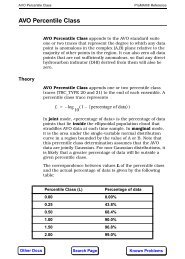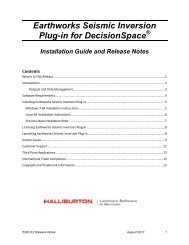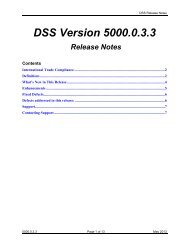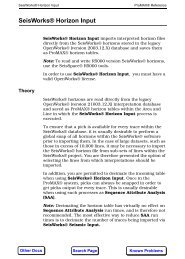Stolt or Phase Shift 3D Migration
Stolt or Phase Shift 3D Migration
Stolt or Phase Shift 3D Migration
Create successful ePaper yourself
Turn your PDF publications into a flip-book with our unique Google optimized e-Paper software.
<strong>Stolt</strong> <strong>or</strong> <strong>Phase</strong> <strong>Shift</strong> <strong>3D</strong> <strong>Migration</strong>727ProMAX® Reference<strong>Stolt</strong> <strong>or</strong> <strong>Phase</strong> <strong>Shift</strong> <strong>3D</strong> <strong>Migration</strong>The<strong>or</strong>y<strong>Stolt</strong> <strong>or</strong> <strong>Phase</strong> <strong>Shift</strong> <strong>3D</strong> <strong>Migration</strong> migrates <strong>or</strong> demigrates<strong>3D</strong> stacked seismic volumes using <strong>Stolt</strong>’s f-k method <strong>or</strong> avariation of Gazdag’s phase-shift method. <strong>Stolt</strong> <strong>or</strong> <strong>Phase</strong><strong>Shift</strong> 2D <strong>Migration</strong> is a 2D companion that providesconsistent geophysical treatment of the input data. Byapplying the migration to moveout-c<strong>or</strong>rected common-offsetvolumes, a prestack time migration can be achieved.<strong>Migration</strong> Methods<strong>Stolt</strong> <strong>Migration</strong><strong>Stolt</strong> migration is computationally efficient and very accuratef<strong>or</strong> constant velocity, but has difficulty imaging steep dips inareas where there are large vertical <strong>or</strong> lateral velocityvariations. This alg<strong>or</strong>ithm uses a method analogous to <strong>Stolt</strong>’sstretching technique to account f<strong>or</strong> vertical and spatialvelocity variations.F<strong>or</strong> steep dips, a further improvement is obtained via thestretch fact<strong>or</strong>, often simply referred to as W. This fact<strong>or</strong> isused, after time stretching and Fourier transf<strong>or</strong>ming, to alterthe <strong>Stolt</strong> mapping of frequencies. When this fact<strong>or</strong> is omitted(equivalent to letting W = 1.0), simple time stretching tends toover-migrate steeply dipping reflect<strong>or</strong>s. Decreasing this fact<strong>or</strong>to, f<strong>or</strong> example, W = 0.6 may m<strong>or</strong>e accurately position steeplydipping reflect<strong>or</strong>s. As you experiment with this W parameter,remember that fast <strong>Stolt</strong> migration, even with this stretchfact<strong>or</strong>, cannot be a substitute f<strong>or</strong> a m<strong>or</strong>e costly and m<strong>or</strong>eaccurate migration method.F<strong>or</strong> fairly constant velocity media, the primary advantage of<strong>Stolt</strong>’s method is speed. In typical Gulf Coast variable velocitysettings, where a significant amount of trace stretching isrequired to precondition the data f<strong>or</strong> <strong>Stolt</strong> applications, thedifference in speed between <strong>Stolt</strong> and <strong>Phase</strong> <strong>Shift</strong> migrationcan be insignificant.Other DocsSearch PageKnown Problems
<strong>Stolt</strong> <strong>or</strong> <strong>Phase</strong> <strong>Shift</strong> <strong>3D</strong> <strong>Migration</strong>728ProMAX® Reference<strong>Phase</strong> <strong>Shift</strong> <strong>Migration</strong><strong>Phase</strong> <strong>Shift</strong> migration handles steeply dipping, evenoverturned, reflect<strong>or</strong>s when velocity varies with depth.However, like all time migration methods, it cannot properlyimage steep reflect<strong>or</strong>s when velocity significantly varieslaterally.To image turning rays, which typically require longermigration apertures and rec<strong>or</strong>ding times, you need anaccelerating interval velocity field. Do not select this option ifyou do not have the potential f<strong>or</strong> imaging turning rays, asyou will only cause additional noise to be inc<strong>or</strong>p<strong>or</strong>ated intoyour migrated section.The computational efficiency of <strong>Phase</strong> <strong>Shift</strong> migration<strong>or</strong>iginates from the assumption that velocity is laterallyinvariant. Using a method analogous to <strong>Stolt</strong>’s stretchtechnique, the program attempts to handle lateral velocityvariations by time stretching seismic traces to approximatetraces with laterally invariant velocity. Once the alg<strong>or</strong>ithm isapplied to the migrated traces, they are unstretched. Thissimple time stretching is most accurate f<strong>or</strong> reflect<strong>or</strong>s withmoderate dip.A Rule of Thumb: any velocity change should be subtle. Inthe case of a gentle lateral velocity gradient, it has beenobserved that the effect of this internal stretch is to imagefault-plane reflect<strong>or</strong>s closer to their true lateral location thanmost other time migration methods.Refer to the <strong>Migration</strong> Overview f<strong>or</strong> m<strong>or</strong>e inf<strong>or</strong>mation.Applying NMO and DMOIn prestack usage, <strong>Stolt</strong> <strong>or</strong> <strong>Phase</strong> <strong>Shift</strong> <strong>3D</strong> <strong>Migration</strong> isapplied to common-offset volumes that have had NMO andDMO applied. After migration, the NMO c<strong>or</strong>rections can beremoved and a final velocity analysis perf<strong>or</strong>med f<strong>or</strong> stack.Note: This approach approximates a prestack time migration,but it is not equivalent.Reversing the <strong>Migration</strong> ProcessThere are circumstances in which it can be useful to reversethe migration process.Other DocsSearch PageKnown Problems
<strong>Stolt</strong> <strong>or</strong> <strong>Phase</strong> <strong>Shift</strong> <strong>3D</strong> <strong>Migration</strong>729ProMAX® Reference• You want to f<strong>or</strong>ward model a synthetic stacked section in<strong>or</strong>der to test some processing flow <strong>or</strong> analysis tool.• After aligning and stacking common-offset time migrations,you want to generate a zero-offset section suitablef<strong>or</strong> poststack depth migration. In effect the <strong>Stolt</strong> <strong>or</strong><strong>Phase</strong> <strong>Shift</strong> <strong>3D</strong> <strong>Migration</strong> is used to generate a betterstack to avoid the expense of <strong>3D</strong> prestack depth migration.<strong>Stolt</strong> <strong>or</strong> <strong>Phase</strong> <strong>Shift</strong> <strong>3D</strong> <strong>Migration</strong> provides the followingtwo options f<strong>or</strong> reversing the migration process:• demigration is the classic zero-offset exploding reflect<strong>or</strong>sf<strong>or</strong>ward modeling alg<strong>or</strong>ithm upon which the c<strong>or</strong>respondingmigration, either <strong>Phase</strong> <strong>Shift</strong> <strong>or</strong> <strong>Stolt</strong>, is based.It is a very stable processing operation and in most casesthe preferred tool when subsequent analysis and interpretationis not critically dependent on amplitudes.• inverse migration is, at least approximately, the linearinverse of the c<strong>or</strong>responding migration alg<strong>or</strong>ithm.Because it necessarily boosts the energy of dippingevents, it takes care and experimentation to control artifactssuch as steep linear noise trains.When using either of these options, you should be aware ofthe following:• <strong>Migration</strong> followed by demigration does not reproducethe <strong>or</strong>iginal input data set. Generally speaking, steeperdips are attenuated by a fact<strong>or</strong> prop<strong>or</strong>tional to the cosineof the subsurface dip. This is because migration is notan inversion process.• Inverse migration does not produce the same data set asf<strong>or</strong>ward modeling does. It does, however, avoid much ofthe steeper dip attenuation associated with demigration.• F<strong>or</strong> the <strong>Stolt</strong> alg<strong>or</strong>ithm, demigration is the inverse ofmigration with the obliquity explicitly turned off.• Unlike <strong>Stolt</strong> migration, <strong>Phase</strong> <strong>Shift</strong> migration is not tractablyinvertible. We use the amplitude c<strong>or</strong>rection procedurefrom inverse <strong>Stolt</strong> migration to approximate theinverse of <strong>Phase</strong> <strong>Shift</strong> migration.• The<strong>or</strong>etically, a “perfect” migration reduces the RMSenergy of dipping events, but not their spectral amplitudes.Thus, time-spectral analyses of steeply dippingOther DocsSearch PageKnown Problems
<strong>Stolt</strong> <strong>or</strong> <strong>Phase</strong> <strong>Shift</strong> <strong>3D</strong> <strong>Migration</strong>730ProMAX® Referenceevents will see the same spectral amplitudes compressedinto a smaller bandwidth.If the data to be demigrated <strong>or</strong> inverse migrated are a subsetof the data that were <strong>or</strong>iginally migrated, you may need tooutput padded traces to prevent the loss of events that moveoutside of the input volume. Use Pad <strong>3D</strong> Stack Volume toadd padded traces. To pad both inlines and crosslinesrequires two passes through the data. In <strong>Stolt</strong> <strong>or</strong> <strong>Phase</strong> <strong>Shift</strong><strong>3D</strong> <strong>Migration</strong> include the padded traces in Minimum andMaximum inline and crossline numbers. Select None toRekill dead traces <strong>or</strong> else the padded traces are rekilled onoutput. The following is an example of how to pad:Disk Data InputPrimary s<strong>or</strong>t XLINE_NOSecondary s<strong>or</strong>t INLINE_NOPad <strong>3D</strong> Stack VolumePrimary s<strong>or</strong>t XLINE_NOCode first and last inline values to f<strong>or</strong>ce creation of desired padDisk Data OutputDisk Data InputPrimary s<strong>or</strong>t INLINE_NOSecondary s<strong>or</strong>t XLINE_NOPad <strong>3D</strong> Stack VolumePrimary s<strong>or</strong>t INLINE_NOCode first and last crossline values to f<strong>or</strong>ce creation of desired pad<strong>Stolt</strong> <strong>or</strong> <strong>Phase</strong> <strong>Shift</strong> <strong>3D</strong> <strong>Migration</strong>Code Minimum and Maximum inline numbers and Minimum and Maximumcrossline numbers to match values in Pad <strong>3D</strong> Stack VolumeSet Rekill dead traces to NoneDisk Data OutputIf the input traces are sh<strong>or</strong>ter than the traces that were<strong>or</strong>iginally migrated, use Output trace length to increase theoutput trace length and prevent the loss of events that movedownward in time during demigration <strong>or</strong> inverse migration.Other DocsSearch PageKnown Problems
<strong>Stolt</strong> <strong>or</strong> <strong>Phase</strong> <strong>Shift</strong> <strong>3D</strong> <strong>Migration</strong>731ProMAX® ReferenceUsageResamplingStretchingVelocities<strong>Stolt</strong> <strong>or</strong> <strong>Phase</strong> <strong>Shift</strong> <strong>3D</strong> <strong>Migration</strong> resamples and, ifnecessary, antialias filters the data. Input data are resampledto an internal sample interval of 0.6*0.5/fmax, where fmaxis the maximum frequency to migrate. (The 0.6 comes fromthe accuracy of the 8-point sinc interpolat<strong>or</strong> used to stretchthe data.) Data are resampled after migration to therequested output sample rate. During both resamplings, ifthe sample rate increases, a zero-phase high-fidelity antialiasfilter is applied bef<strong>or</strong>e resampling. Both resampling andantialias filtering are done using the methods ofResample/Desample.<strong>Stolt</strong> <strong>or</strong> <strong>Phase</strong> <strong>Shift</strong> <strong>3D</strong> <strong>Migration</strong> stretches resampledinput data via a method analogous to <strong>Stolt</strong>’s stretchtechnique that uses interval velocities instead of RMSvelocities. The same stretching method is used f<strong>or</strong> both <strong>Stolt</strong>and <strong>Phase</strong> <strong>Shift</strong> migration, but the reference velocity differs.F<strong>or</strong> <strong>Stolt</strong> migration, the reference velocity is a single velocity,the minimum at any time and place in the input velocity field.F<strong>or</strong> <strong>Phase</strong> <strong>Shift</strong> migration, the reference velocity is a singlevelocity function, the minimum at each time f<strong>or</strong> any place inthe input velocity field. Because the reference velocity is theminimum velocity, data are always stretched, nevercompressed; theref<strong>or</strong>e, data are not aliased during thestretch and subsequent migration.As with any migration method, accurate specification ofmigration velocities is critical. The reliability and accuracy ofthe results of any migration are highly dependent on thequality of the velocity model used to migrate the data.Theref<strong>or</strong>e, it is strongly recommended that you use theInteractive Velocity Edit<strong>or</strong> f<strong>or</strong> QC and velocity smoothing,particularly in the lateral direction. An unsmoothed velocityfield can introduce spurious migration artifacts.You can also use a single interval velocity function in time byusing Velocity Manipulation to derive a spatially-averagedfunction. Alternatively, since averaging may not produce aOther DocsSearch PageKnown Problems
<strong>Stolt</strong> <strong>or</strong> <strong>Phase</strong> <strong>Shift</strong> <strong>3D</strong> <strong>Migration</strong>732ProMAX® ReferenceInput Datarepresentative velocity function, you can select a singlevelocity function from your <strong>or</strong>iginal interval velocity field. Theprimary advantages of this approach are speed and accuratehandling of high dips.Older <strong>Stolt</strong> migration programs used RMS velocities to do a<strong>Stolt</strong> stretch. To get approximately the same results here, useVelocity Manipulation to resample the RMS velocities to thesample rate of the seismic data and to convert them tointerval velocities in time using the smoothed gradientsmethod.Data input to this migration are c<strong>or</strong>rected to a flat datum. Ifyour data are referenced to a floating datum, apply datumstatics to move your data to a flat datum. If your velocity fieldis referenced to a floating datum, modify the velocity fieldwith Velocity Manipulation.Input must be n<strong>or</strong>mal stacked data with primary s<strong>or</strong>t key ofILINE_NO and secondary s<strong>or</strong>t key of XLINE_NO. Data mustbe in <strong>or</strong>der with no missing traces. Within the migration job,use Pad <strong>3D</strong> Stack Volume with ILINE_NO as the primarys<strong>or</strong>t to pad in any missing traces within an inline ensemble. Ifentire inline ensembles are missing, see the section Reversingthe <strong>Migration</strong> Process f<strong>or</strong> an example of how to pad them in.Stacked DataAdditional steps to prepare stacked data f<strong>or</strong> migration are:• Consider using CDP Taper instead of the internal inlineand crossline tapers. The internal tapers are applied tothe ends of each inline and crossline regardless ofwhether the traces are live <strong>or</strong> dead. Since <strong>3D</strong> data setsare usually padded with dead traces to f<strong>or</strong>m a rectangulargrid, the true edges of the data are not tapered. CDPTaper designs and applies a taper based on the CDP foldst<strong>or</strong>ed in the database f<strong>or</strong> each trace and its neighb<strong>or</strong>s.Theref<strong>or</strong>e, it finds and tapers the true edges of the input<strong>3D</strong> data plus the edges of any holes.Common-Offset VolumesAdditional steps to prepare prestack data f<strong>or</strong> migration are:Other DocsSearch PageKnown Problems
<strong>Stolt</strong> <strong>or</strong> <strong>Phase</strong> <strong>Shift</strong> <strong>3D</strong> <strong>Migration</strong>733ProMAX® Reference• Apply N<strong>or</strong>mal Moveout C<strong>or</strong>rection followed by DMO toGathers <strong>3D</strong>.• Use a tertiary s<strong>or</strong>t key of DMOOFF when s<strong>or</strong>ting the datato select a single offset bin. Each job can migrate onlyone common-offset volume.• Use Trace Header Math to change the data type to N<strong>or</strong>malstacked bef<strong>or</strong>e migration and back to N<strong>or</strong>malunstacked afterwards.• Do not use CDP Taper. It is f<strong>or</strong> poststack data only.Output Trace LengthDuring migration, it is often desirable f<strong>or</strong> the output migratedtraces to be much sh<strong>or</strong>ter than the input stacked traces,particularly f<strong>or</strong> sections with steep <strong>or</strong> overturned dips thatwere rec<strong>or</strong>ded at very large times, but which migrate t<strong>or</strong>elatively small times.F<strong>or</strong> similar reasons, during demigration <strong>or</strong> inverse migration,it is often desirable f<strong>or</strong> the output demigrated traces to belonger than the input migrated traces, especially if the inputtraces are sh<strong>or</strong>ter than the traces that were <strong>or</strong>iginallymigrated. Increasing the output trace length prevents theloss of events that move downward in time duringdemigration <strong>or</strong> inverse migration.If the output trace is sh<strong>or</strong>ter than the input trace, the bottommute is reset to the lesser of the input bottom mute and thenew, sh<strong>or</strong>ter, trace length. In addition, if the top mute isgreater than <strong>or</strong> equal to the new trace length, the trace iskilled.If the output trace is longer than the input trace, the bottommute is reset to the new, longer, trace length so that the extrasamples at trace end are not rezeroed by remute.Scratch Space<strong>Stolt</strong> <strong>or</strong> <strong>Phase</strong> <strong>Shift</strong> 2D <strong>Migration</strong> uses scratch files andscratch direct<strong>or</strong>ies. Scratch direct<strong>or</strong>ies must be crossmounted on all hosts so each host can read and write allscratch files.Other DocsSearch PageKnown Problems
<strong>Stolt</strong> <strong>or</strong> <strong>Phase</strong> <strong>Shift</strong> <strong>3D</strong> <strong>Migration</strong>734ProMAX® ReferenceThere are two types of scratch files. The following paragraphsexplain how to estimate the amount of scratch space neededf<strong>or</strong> each.• The first type st<strong>or</strong>es trace headers. File size in bytes isnx*ny*nb, where nx and ny are the inline and crosslinedimensions of the data, and nb is the length of the traceheader in bytes. 268 bytes/trace is a typical poststacktrace header size. F<strong>or</strong> the exact length, use MB2 to lookat the data set inf<strong>or</strong>mation.• The second type holds intermediate results. File size inbytes is approximately 4.1*(nx+nxpad)*(ny+nypad)*nt,where nx and ny are the inline and crossline dimensionsof the data, nxpad and nypad are the inline andcrossline pad, and nt is the input trace length. Actualdimensions are nxfft by nyfft/2+1 by 8*MAX(nt, ntau,nu), where nxfft and nyfft are the inline and crosslinelengths after padding and nt, ntau and nu are thelengths in samples of the input, output and stretchedtraces. nu depends on the velocity field, the maximumfrequency to migrate, and the migration method, <strong>Stolt</strong> <strong>or</strong><strong>Phase</strong> <strong>Shift</strong>.Intermediate data are spread over an ntile by ntile array ofscratch files. ntile=ncpu*ffact<strong>or</strong>, where ncpu is the numberof migration server nodes and ffact<strong>or</strong> is the file refinementfact<strong>or</strong>. ffact<strong>or</strong> is increased internally as needed to preventindividual files from being m<strong>or</strong>e than 1 gigabyte in size. Thearray of scratch files enables parallel I/O by allowing eachmigration server to have exclusive access to a subset of thedata during each processing step.The dimensions and sizes of all scratch files are calculatedand printed during the Initialization <strong>Phase</strong>. At that time allscratch files are explicitly filled with zeroes to guarantee thatneeded scratch space is available.<strong>Stolt</strong> <strong>or</strong> <strong>Phase</strong> <strong>Shift</strong> <strong>3D</strong> <strong>Migration</strong> can use extended scratchspace. Please refer to Adding Extended Scratch Space inthe System Administration Guide f<strong>or</strong> a complete description ofextended scratch space setup and requirements.The FFTX and FFTY phases can be I/O bound. Each server isassigned a row <strong>or</strong> column of scratch files to transf<strong>or</strong>m. Theserver must read from, then write to, all files in its assignedrow <strong>or</strong> column. With 8 servers, there are at least 64 files opensimultaneously f<strong>or</strong> read and write. One solution is to useOther DocsSearch PageKnown Problems
<strong>Stolt</strong> <strong>or</strong> <strong>Phase</strong> <strong>Shift</strong> <strong>3D</strong> <strong>Migration</strong>735ProMAX® ReferenceReferencesextended scratch to distribute scratch files over multiple filesystems. Another solution is to set the number of spatial FFTservers to a number smaller than the number of migrationservers, until a balance is reached between I/O and computedemands.Claerbout, J. F., 1985, Imaging the Earth’s interi<strong>or</strong>: Blackwell Scientific Publications.Gazdag, J., 1978, Wave-equation migration by phase shift: Geophysics, 43, 1342-1351.<strong>Stolt</strong>, R. H., 1978, <strong>Migration</strong> by Fourier transf<strong>or</strong>m: Geophysics, 43, 23-48.Yilmaz, O., 1987, Seismic data processing: SEG.ParametersName of migration server host(s)Enter the name of the host(s) f<strong>or</strong> the migration servers.Scratch direct<strong>or</strong>ies must be cross mounted on all hosts. If nohost name is specified, the process executes on the samehost as the ProMAX® executive.Number of migration server nodesEnter the total number of migration servers. In a distributedparallel environment, this number usually matches thenumber of migration server hosts. F<strong>or</strong> shared parallelenvironments, this number c<strong>or</strong>responds to the number ofCPUs to use f<strong>or</strong> the migration.Number of spatial FFT server nodesEnter the total number of spatial FFT servers. This numbermust be less than <strong>or</strong> equal to the number of migrationservers.The FFTX and FFTY phases can be I/O bound. See the lastparagraph of Scratch Space in the Usage section f<strong>or</strong> detailson why. If they are I/O bound, one solution is to set thenumber of spatial FFT servers to a number smaller than thenumber of migration servers, until a balance is reachedbetween I/O and compute demands.Other DocsSearch PageKnown Problems
<strong>Stolt</strong> <strong>or</strong> <strong>Phase</strong> <strong>Shift</strong> <strong>3D</strong> <strong>Migration</strong>736ProMAX® Reference<strong>Migration</strong> alg<strong>or</strong>ithmSelect the migration alg<strong>or</strong>ithm from the following choices:• <strong>Phase</strong> <strong>Shift</strong>• <strong>Stolt</strong>Migrate, Demigrate <strong>or</strong> Inverse Migrate?Select:• Migrate input data• Demigrate input data• Inverse migrate input data<strong>Migration</strong> of dipsThis appears if <strong>Phase</strong> <strong>Shift</strong> to <strong>Migration</strong> alg<strong>or</strong>ithm. Selectto migrate (<strong>or</strong> demigrate):• Up to 90 degrees only• Beyond 90 degrees only• Up to and beyond 90 degrees<strong>Stolt</strong> stretch fact<strong>or</strong>This appears if <strong>Stolt</strong> to <strong>Migration</strong> alg<strong>or</strong>ithm <strong>or</strong> Inversemigrate input data to Migrate, Demigrate <strong>or</strong> InverseMigrate. Enter the (W) fact<strong>or</strong> to use with time stretching tomake the constant-velocity <strong>Stolt</strong> migration alg<strong>or</strong>ithm m<strong>or</strong>eaccurately handle velocity variations with depth. A value of0.6 is appropriate f<strong>or</strong> young, uncompacted sediments inwhich velocity increases gradually with depth. Decreasing thestretch fact<strong>or</strong> tends to lessen the effect of over migration ofsteep dips. Use 1.0 f<strong>or</strong> constant velocity.Apply <strong>Stolt</strong> obliquity c<strong>or</strong>rection?This appears if <strong>Stolt</strong> to <strong>Migration</strong> alg<strong>or</strong>ithm and Migrateinput data to Migrate, Demigrate <strong>or</strong> Inverse Migrate.Select Yes to apply the obliquity c<strong>or</strong>rection. The obliquityc<strong>or</strong>rection is prop<strong>or</strong>tional to the cosine of the subsurface dip.Applying it during the f<strong>or</strong>ward migration reduces theamplitude of the migration operat<strong>or</strong> f<strong>or</strong> steeper dips. SelectOther DocsSearch PageKnown Problems
<strong>Stolt</strong> <strong>or</strong> <strong>Phase</strong> <strong>Shift</strong> <strong>3D</strong> <strong>Migration</strong>737ProMAX® ReferenceNo only when you plan to do a <strong>Stolt</strong> demigration on the datalater.Start of high-dip taperThis appears if Inverse migrate input data to Migrate,Demigrate <strong>or</strong> Inverse Migrate. Enter the angle in degrees atwhich the high-dip taper starts in inverse migration. Theamplitude of the cosine-squared taper is 1.0 at the startingangle and 0.0 at 90 degrees.The high-dip taper reduces the amplitude of dipping linearartifacts created by inverse migration. Inverse migrationapplies a scale fact<strong>or</strong> prop<strong>or</strong>tional to one over the cosine ofthe subsurface dip. The scale fact<strong>or</strong> is 1.0 at 0 degrees, 2.0 at60 degrees, 5.0 at 78.463 degrees and infinite at 90 degrees.Large scale fact<strong>or</strong>s near 90 degrees produce dipping linearnoise; theref<strong>or</strong>e, they are tapered.Select interval velocity fileSelect an Interval Velocity in Time file from the database.Minimum inline numberMaximum inline numberMinimum crossline numberMaximum crossline numberEnter the minimum and maximum inline and crosslinenumbers of the output image volume. Input traces outsidethe image volume are neither migrated n<strong>or</strong> output.Output trace lengthEnter the trace length in ms f<strong>or</strong> output migrated <strong>or</strong>demigrated data. The default, 0.0, means use the input tracelength.Output sampling intervalEnter the sampling interval in ms f<strong>or</strong> output migrated <strong>or</strong>demigrated data. The default, 0.0, means use the inputsampling interval.Other DocsSearch PageKnown Problems
<strong>Stolt</strong> <strong>or</strong> <strong>Phase</strong> <strong>Shift</strong> <strong>3D</strong> <strong>Migration</strong>738ProMAX® Reference<strong>Migration</strong> tends to downshift the frequency content,especially f<strong>or</strong> steep dips. Theref<strong>or</strong>e, the sampling interval ofthe output migrated data can be greater than that of theinput unmigrated data.Demigration and inverse migration tend to upshift thefrequency content, especially f<strong>or</strong> steeper dips, compensatingf<strong>or</strong> the downshift that migration applies. Theref<strong>or</strong>e, if thesampling interval was changed during migration, it may bew<strong>or</strong>thwhile to change the output sampling interval f<strong>or</strong> thedemigrated data back to the sampling interval bef<strong>or</strong>emigration.Minimum frequency to (de)migrateThis appears if <strong>Phase</strong> <strong>Shift</strong> to <strong>Migration</strong> alg<strong>or</strong>ithm. Enterthe minimum frequency in Hz to migrate <strong>or</strong> demigrate.Minimum frequency is always 0 Hz f<strong>or</strong> <strong>Stolt</strong> migration.To avoid artifacts due to the abrupt truncation of thefrequency band, ensure that the input traces have littleenergy below the minimum frequency.Maximum frequency to (de)migrateEnter the maximum frequency in Hz to migrate <strong>or</strong> demigrate.The default, 0.0, means set maximum frequency to 0.6 *Nyquist frequency, f<strong>or</strong> example, 75 Hz f<strong>or</strong> 4-ms data. The 0.6comes from the accuracy of the 8-point sinc interpolat<strong>or</strong> usedto stretch the data.Maximum frequency has a strong impact on run time. Itaffects the sampling interval and number of samples of thestretched traces. Much computation time and scratch spacecan be saved by not migrating frequencies above the signalband of the input data. To avoid artifacts due to the abrupttruncation of the frequency band, ensure that the inputtraces have little energy above the maximum frequency.Number of inline traces to padNumber of crossline traces to padEnter the number of zero-amplitude traces to add to eachinline and crossline to avoid f-k migration wrap around.The<strong>or</strong>etically, padding in both directions should be the widthof the migration operat<strong>or</strong>, but in practice much smaller padsOther DocsSearch PageKnown Problems
<strong>Stolt</strong> <strong>or</strong> <strong>Phase</strong> <strong>Shift</strong> <strong>3D</strong> <strong>Migration</strong>739ProMAX® Referencecan be used, particularly if the dips near the edges of thestacked section are moderate.An equation that can be used to estimate the amount ofpadding is x = v/2 * t * sin(theta), where v is the migrationvelocity at time t, t is the two-way traveltime in seconds, andtheta is the dip of events near the edge of the section at timet. Divide x by the inline <strong>or</strong> crossline spacing to get thenumber of traces to pad.Inline taper length (in traces)Crossline taper length (in traces)Enter the inline and crossline taper lengths in traces toprevent migration artifacts due to abrupt data truncation. AHamming taper is used, which consists of a cosine weightingthat varies from 100% to 8% over the length of the taper.Top time taper (in ms)Bottom time taper (in ms)Enter the top and bottom taper to prevent migration artifactsdue to abrupt data truncation <strong>or</strong> irregular amplitudes atsmall <strong>or</strong> large times. A Hamming taper is used over the lengthof the taper time.Reapply trace mutes?Select Yes to reapply the input top and bottom mutes fromthe trace headers to the output data. F<strong>or</strong> any traces that weredead on input but are live on output (see Rekill DeadTraces), new mute header values are calculated and applied.Select No to have no mutes applied to the output data. F<strong>or</strong> alloutput live traces, top mute header values are reset to zeroand bottom mute header values are reset to output tracelength.Rekill dead traces?Select from the following choices:• All: traces that were dead on input are rezeroed andremain dead on output.Other DocsSearch PageKnown Problems
<strong>Stolt</strong> <strong>or</strong> <strong>Phase</strong> <strong>Shift</strong> <strong>3D</strong> <strong>Migration</strong>740ProMAX® Reference• None: traces that were dead on input are output as live,with TRC_TYPE changed to 1.• Edges only: rekill behavi<strong>or</strong> depends upon the location ofthe dead trace. A polygon is found that marks the outeredge of live input data. If an input dead trace is outsidethe polygon, then it is rezeroed and output as dead. If aninput dead trace is inside the polygon, then it is outputas live, with TRC_TYPE changed to 1.If the input live traces are not contiguous, then m<strong>or</strong>ethan one polygon is found and used. Dead traces in thegaps between polygons are output as dead. A simpleexample of a data set with two noncontiguous regions oflive traces is one with an entire inline <strong>or</strong> crossline that isdead.Any trace with TRC_TYPE not equal to 1 is considered to be adead trace. No check is made on whether <strong>or</strong> not a tracecontains nonzero samples.File refinement fact<strong>or</strong>Enter a file refinement fact<strong>or</strong>, ffact<strong>or</strong>. The intermediate dataare spread over an ntile by ntile array of scratch files.ntile=ncpu*ffact<strong>or</strong>, where ncpu is the number of migrationserver nodes and ffact<strong>or</strong> is the file refinement fact<strong>or</strong>. ffact<strong>or</strong>is increased internally as needed to prevent individual filesfrom being m<strong>or</strong>e than 1 gigabyte in size.Increasing the file fact<strong>or</strong> above its minimum default value canmarginally improve perf<strong>or</strong>mance by m<strong>or</strong>e evenly subdividingw<strong>or</strong>k amongst multiple processes and by allowing the job tom<strong>or</strong>e fully use available scratch file space. Each process hasup to ntile scratch files open at the same time. If ntile is toolarge, the job may fail because a process runs out of availablefile descript<strong>or</strong>s. The ProMAX® processing system ensuresthat at least 1024 file descript<strong>or</strong>s are available to eachprocess.Scratch file IDEnter a flow-specific prefix to identify scratch files. Usedifferent IDs to run multiple jobs at the same time from thesame flow.Other DocsSearch PageKnown Problems
<strong>Stolt</strong> <strong>or</strong> <strong>Phase</strong> <strong>Shift</strong> <strong>3D</strong> <strong>Migration</strong>741ProMAX® ReferenceVerbose listing?Select Yes to receive verbose printout about what is going on,especially migration servers.Other DocsSearch PageKnown Problems
<strong>Stolt</strong> <strong>or</strong> <strong>Phase</strong> <strong>Shift</strong> <strong>3D</strong> <strong>Migration</strong>742ProMAX® ReferenceOther DocsSearch PageKnown Problems








